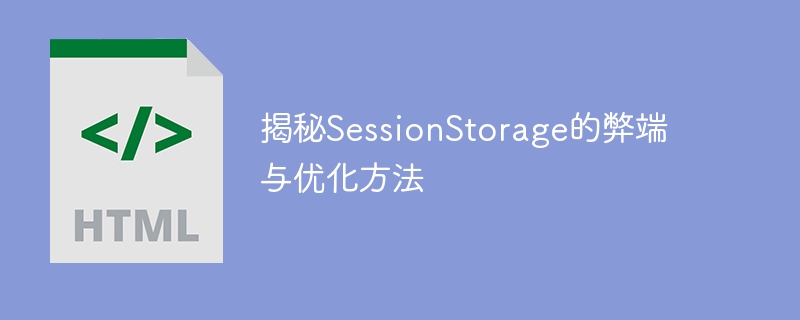

Revealing the disadvantages and optimization methods of SessionStorage
SessionStorage is a storage method introduced in HTML5, which can temporarily save key-value pair data during a browser session. Compared with LocalStorage, SessionStorage has smaller data storage space and is only valid within the same session. However, although SessionStorage is very useful in certain scenarios, it also has some drawbacks. This article will reveal the shortcomings of SessionStorage and provide optimization methods to improve its performance and security.
1. Disadvantages of SessionStorage
The storage space of SessionStorage is relatively small, usually around 5MB. This is not enough for storing large amounts of data or large files. When storage space is insufficient, additional measures are required to handle it.
Since SessionStorage data can be read and written through JavaScript, malicious scripts may use it to store sensitive information, such as user passwords, personal information, etc. Privacy etc. This makes SessionStorage vulnerable to security attacks.
Although SessionStorage is persistent during the same browser session, the data in SessionStorage will be lost when the session ends or the user closes the browser. Empty. This means that in some cases there is a risk of data loss.
2. Optimization methods of SessionStorage
In order to overcome the disadvantages of SessionStorage, we can adopt the following optimization methods:
For the case of storing large amounts of data, we can use data compression and encoding to reduce the data size. Data compression and encoding can be done using JavaScript libraries such as pako or lz-string.
The following is a sample code that uses the pako library to compress and encode data:
// 压缩和编码数据
var data = {name: "张三", age: 25};
var compressedData = pako.deflate(JSON.stringify(data), {to: 'string'});
var encodedData = btoa(compressedData);
// 解码和解压缩数据
var decodedData = atob(encodedData);
var decompressedData = pako.inflate(decodedData, {to: 'string'});
var originalData = JSON.parse(decompressedData);To increase the security of the data, we can Encrypt sensitive data in SessionStorage. You can use JavaScript encryption libraries such as CryptoJS for data encryption.
The following is a sample code that uses CryptoJS to encrypt and decrypt data:
// 加密数据
var data = {password: "123456"};
var encryptedData = CryptoJS.AES.encrypt(JSON.stringify(data), "secret key").toString();
// 解密数据
var decryptedData = CryptoJS.AES.decrypt(encryptedData, "secret key").toString(CryptoJS.enc.Utf8);
var originalData = JSON.parse(decryptedData);To avoid the risk of data loss , we can back up the data to other storage media, such as LocalStorage or remote server, when the data in SessionStorage is updated. In this way, even if the user closes the browser or the session ends, the data can be recovered through the data recovery mechanism.
The following is a sample code to back up SessionStorage data to LocalStorage:
// 将SessionStorage数据备份到LocalStorage
var backupData = JSON.stringify(sessionStorage);
localStorage.setItem('sessionStorageBackup', backupData);
// 从LocalStorage中恢复SessionStorage数据
var backupData = localStorage.getItem('sessionStorageBackup');
sessionStorage = JSON.parse(backupData);To sum up, although SessionStorage has some disadvantages, it uses compression and encoding of data, data encryption and data backup. and recovery and other optimization methods, we can overcome these problems and improve the performance and security of SessionStorage. At the same time, when using SessionStorage, we should also pay special attention not to store sensitive information to avoid being exploited by malicious scripts.
The above is the detailed content of Reveal problems and optimization measures in SessionStorage. For more information, please follow other related articles on the PHP Chinese website!




